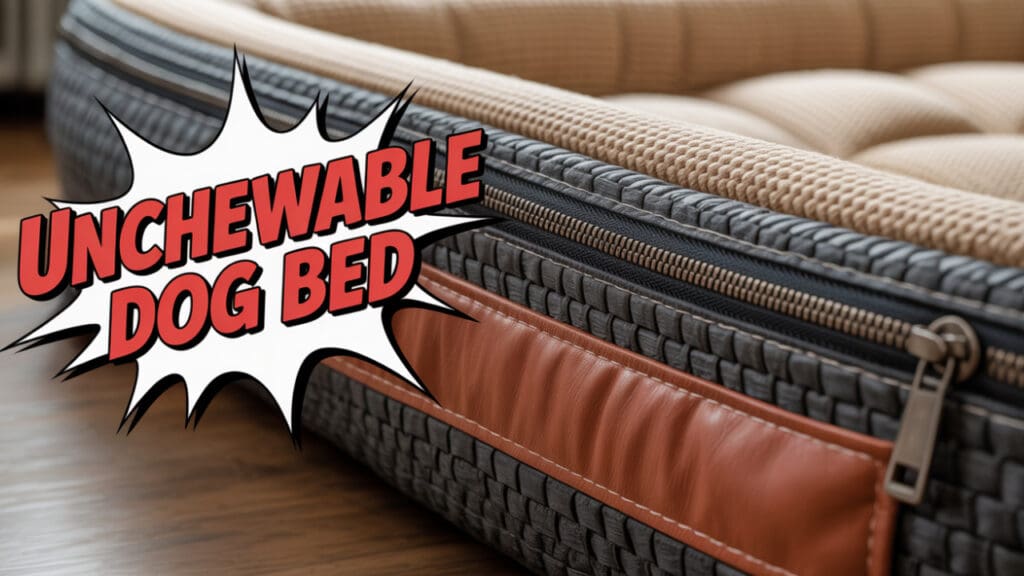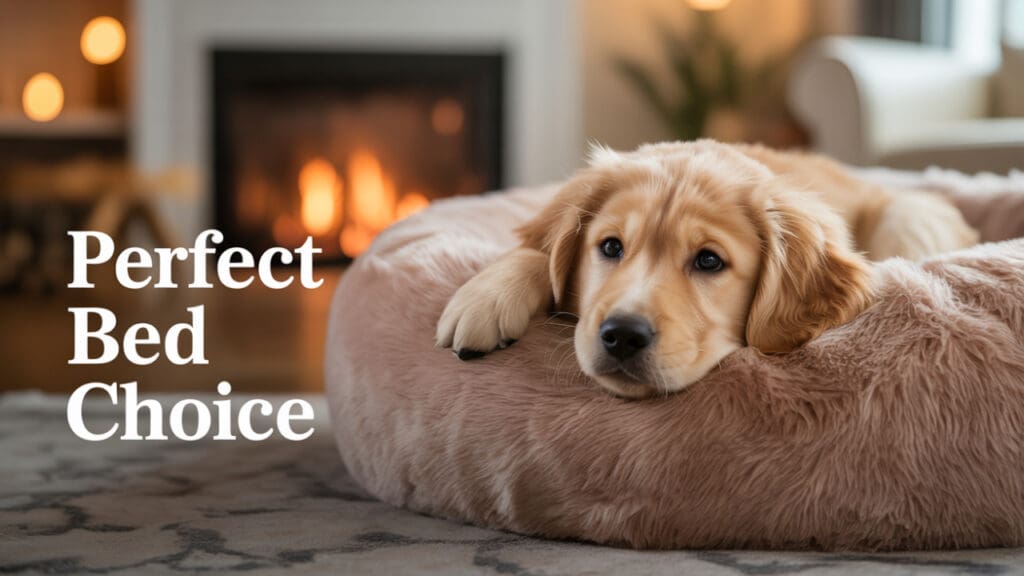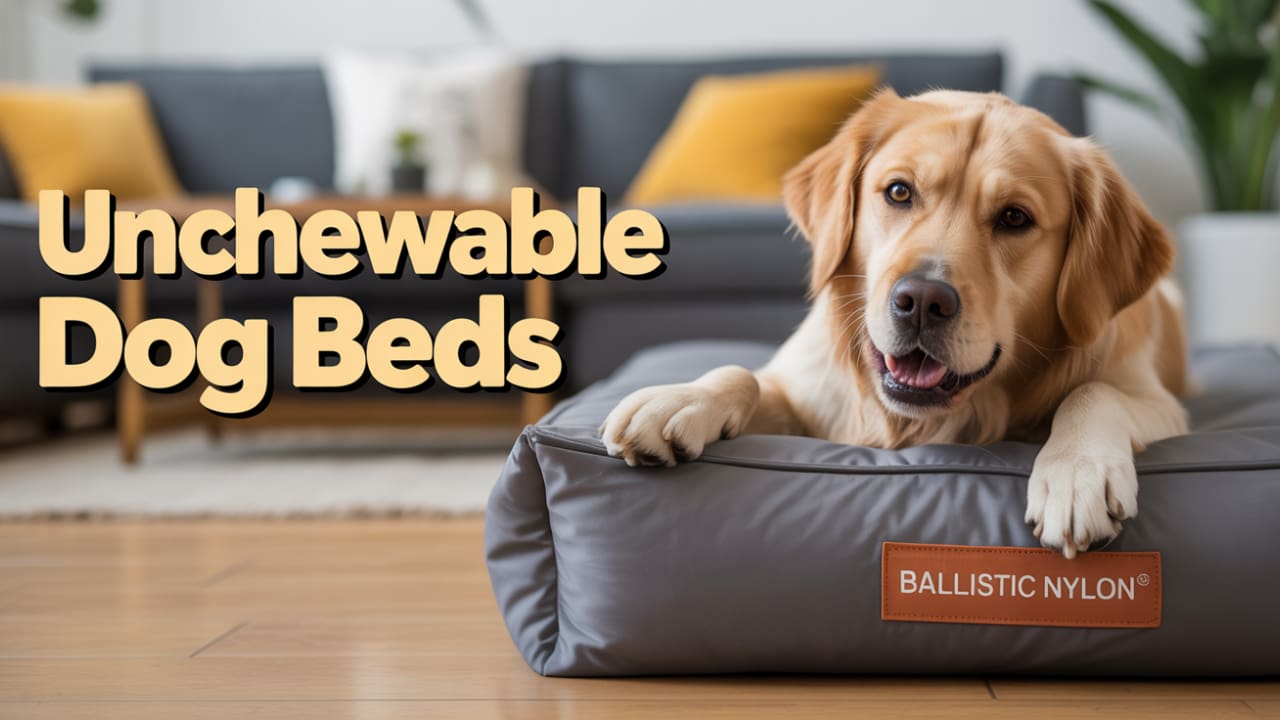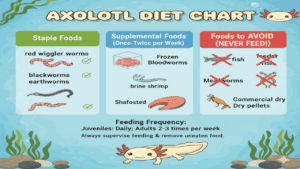Best Dog Bed for Chewers (2025): Expert Buying Guide on Materials, Behavior Matching, Durability, and Mistakes to Avoid
So, you’d finished picking out the best-looking bed for your canine friend. You brought it home, set it down, tag’s still intact. You turned away and bam. Your dog’s turned that bed into their now-shredded chew toy. Money down the drain.
What can you do about this? It’s your dog’s thing to do this to their beds, but you can’t seem to find one that’s “indestructible.” That’s quite the dream there.
Now, the best dog bed for chewers should indeed be made of tougher fabric. It is, after all, a tool designed with the purpose of outsmarting your little one’s destructive habits. And it’s ultimately supposed to help you save money in the long run.
In terms of material and construction, you should be aiming for ballistic nylon and hidden seams. They resist chewing. And they can help eliminate common chew triggers.
That said, you should understand that “chew-proof” doesn’t mean indestructible. So, don’t go thinking that a dog bed with that label will last you a lifetime. It’s simply not possible.
Still, you’ll need to make a choice between two dog beds with the same label. Let’s learn how a chew-resistant differs from an orthopedic one. The latter should come with a tear-resistant cover and a warranty.
We’ll also check out how factors like your dog’s breed, size, and behavior patterns can affect how durable the bed can be. You should know that where you place the bed can play a part in this, too.
Additionally, we’ll take a look at why a lot of these so-called “tough beds” out there fail. Spoilers, it’s because they prioritize looks, not function.
Chew-Proof Dog Bed Finder
Find the perfect bed for your destructive chewer in 2025
Step 1 of 5
Step 2 of 5
Step 3 of 5
Step 4 of 5
Step 5 of 5
Your Perfect Chew-Proof Dog Bed
For Large Breed Aggressive Chewer
Based on your dog's chewing habits and needs
Ideal Material: 1680D Ballistic Nylon
Ballistic Nylon
Military-grade durability
Reinforced Seams
Double-stitched and hidden
Waterproof Liner
For accidents and drool
Key Features:
- Chew Warranty: Look for at least a 1-year chew guarantee
- Seamless Design: No exposed edges or corners to target
- Elevated Base: Minimizes chewable surfaces
- Removable Cover: Machine washable for easy cleaning
- Non-Slip Bottom: Prevents sliding and displacement frustration
Chew Prevention Tips:
- Pair with bitter apple spray on seams
- Provide durable chew toys (Kong Extreme, GoughNuts)
- Consider Adaptil calming pheromones
- Increase exercise and mental stimulation
What Makes the Best Dog Bed for Chewers Different from Regular Beds

Well, you might have just spent more money on another test subject your dog’s supposed to sleep on. It’s now in shreds. Perhaps your canine friend is doing it out of anxiety, boredom, or sheer instinct?
In any case, a standard plush bed just doesn’t cut it. You need a bed for your chewer. But what exactly sets the best dog bed for chewers apart from regular ones?
First thing, you can expect the material to be much tougher. Regular dog beds might use soft fleece, microfiber, or cotton blends. On the other hand, chew-resistant ones are built with high-denier fabrics like ballistic nylon, ripstop canvas, or reinforced polyester.
These materials are meant to resist punctures, tearing, and fraying. Some brands even go as far as to make these dog beds meet military-grade durability standards. So, they are quite ideal for persistent chewers.
The best dog bed for a chewer stands out because it doesn’t just rely on fabric. The strategic design elements (like hidden zippers, seamless edges, and non-slip bottoms) help remove chew targets altogether. So, if your dog can’t find a target point to chew, they’re less likely to chew.
As you can expect, chew-resistant beds are usually more expensive upfront. One can range from $300 to $400+. But you should also understand that investing in the most durable dog bed for chewers (the best you can find) can save you money in the long run. Look for one that comes with a chew warranty or replacement guarantee. That’ll help you out even more.
Key Materials to Look For in a Chew-Resistant Dog Bed
Let’s take a deeper look at the materials for the best dog bed for chewers. These are the deciding factors of whether your dog’s bed will end up in the trash can or not.
Experts and vets generally agree that ballistic nylon is one of the (if not the) best materials for our chewers. The fabric was originally developed for military applications. It is ultra-durable. It resists tearing, fraying, and puncturing, which are likely the favorite tactics of your power chewer.
Ballistic nylon is also smooth and tightly woven. Plus, it doesn’t have the soft fibers that your dog can sink their teeth into. So, this is likely the best material for making the strongest dog bed for chewers.
The next one is ripstop canvas. It’s a rugged material that you may find in many outdoor gear. The fabric combines natural texture with reinforced threading so that it can prevent rips from spreading. It’s not exactly as chew-proof as ballistic nylon. But it’s still one of the best materials out there, especially for a pup that’s more of a “gnawer” than a “destroyer.”
Some dog beds also use PVC-backed polyester or vinyl-coated mesh. They can further help resist bites and make the beds waterproof. This, in turn, also makes the dog bed great for the outdoors.
Now, don’t assume that all “tough” fabrics are the same. The cheaper polyester blends or thick cotton might look strong to you. But they do encourage chewing behavior. Product testers encourage us to look for something with reinforced stitching, hidden seams, and chew-resistant certifications.
Advanced Materials in 2025 Dog Beds

Dog beds in 2025 are getting stronger thanks to new materials. Instead of just using regular tough fabric like ballistic nylon, companies are now trying out graphene fabrics. These are super strong and resist tearing better than old materials.
Another cool new feature is self-healing materials. This means if the bed gets a small cut or scratch, it can fix itself over time. These materials are still new in pet products but could help dog beds last much longer.
To check if a dog bed is really strong, look for ASTM test results. For example:
- ASTM D3884 shows how well it resists wear and tear
- ASTM D5034 shows how much pulling force the fabric can take
Good quality fabric like 1680D ballistic nylon should:
- Handle over 1000 wear cycles
- Withstand pulling force of 845+ lbs
Understanding Dog Bed Ideas for Chewers and Their Unique Features
You want your dog’s bed to look cool. We get it. But you’ll also need to make sure to match form with function. After all, the best dog bed for tough chewers should remove your little one’s temptation to chew and help reinforce good habits.
One of the more effective design ideas is the elevated cot-style bed. These beds use a suspended fabric surface on a durable frame. They minimize edges and corners that your canine friend loves to bite on. Vets say that these beds may also help with joint support and airflow, meaning it’s great for larger dogs that are prone to overheating.
The next contender is memory foam beds that are encased in ballistic nylon covers. These beds offer orthopedic support. So, they are actually good for that aging canine partner of yours. Also, the beds typically use ultra-tough material to prevent destructive chewing. You may even find some premium models that have modular components (removable covers and inner liners). You’d understand if you had ever thought of just tossing the entire dog bed into the washer.
Remember, don’t just choose the bed based on appearances or how soft it feels. You’ll need to look at the structure. Try to avoid beds with exposed seams, decorative zippers, or plush textures. You might think they look cozy, but they’re more like targets for your canine friend.
Why Size, Breed, and Behavior Matter When Choosing the Right Bed

So, what’s next after material and design? Well, you should always keep in mind that the bed needs to fit. And that means size, breed, and behavior matter. A dog bed for a mellow Cocker Spaniel is unlikely to last for a teething Labrador or a high-energy German Shepherd. You can count on that.
Let’s take a look at size first. Just like us humans, your dog needs room to stretch, sprawl, or curl. They have their own sleep style, after all. If their bed’s too small, they may ignore it. But the worst part is your dog trying to “reshape” it.
Now, the large best dog bed for chewers should be reasonably generous in size. You should also look for one with extra reinforcement around the edges and seams. Your heavy canine partner does tend to apply more pressure on these areas. Pick a chew-resistant bed that’s XL or XXL if you happen to have a large breed at home, like Mastiffs, Great Danes, or Rottweilers.
You should understand that some breeds can be quite the persistent chewers. Think terriers or huskies. So, the best dog bed for aggressive chewers should combine ultra-durable materials with a distraction-minimizing design.
Also, note that canine behaviorists mention that some dogs chew because of anxiety. Some may even do so due to lack of stimulation. And that means the bed itself might not always be the root cause.
By the way, don’t assume your little one will “grow out” of chewing. Some puppies do, but many adult dogs just continue their chewing spree all throughout their lives. You can try to pair the right bed with chew-proof toys and top it off with behavioral support. This could help break the habit, not just patch over it.
AI-Driven Behavior Matching & Tiered Durability System
Experts now use AI and real bite force data to match dog beds to how strongly a dog chews. This system is called the Chew-Destruction Index (CDI) and has 5 levels, based on how powerful the dog’s bite is.
Chew-Destruction Index (CDI) – 5-Level System Based on Verified Bite Force
- Level 1: Light Nibblers (100–200 PSI)
- Breeds: Beagles, Pugs, Small Terriers
- Recommended Material: Reinforced canvas is enough
- Breeds: Beagles, Pugs, Small Terriers
- Level 2: Moderate Chewers (200–300 PSI)
- Breeds: Labrador Retriever (230 PSI), Golden Retriever
- Recommended Material: Light ballistic nylon
- Breeds: Labrador Retriever (230 PSI), Golden Retriever
- Level 3: Heavy Chewers (300–400 PSI)
- Breeds: German Shepherd (238 PSI), Rottweiler (328 PSI)
- Recommended Material: 1680D ballistic nylon
- Breeds: German Shepherd (238 PSI), Rottweiler (328 PSI)
- Level 4: Aggressive Chewers (400–600 PSI)
- Breeds: American Bulldog (305 PSI), Wolfdog (406 PSI)
- Recommended Material: Military-grade fabric with welded seams
- Breeds: American Bulldog (305 PSI), Wolfdog (406 PSI)
- Level 5: Power Destroyers (600+ PSI)
- Breeds: Kangal (743 PSI), Cane Corso (700 PSI)
- Recommended Material: Highest durability materials, often with a lifetime warranty
- Breeds: Kangal (743 PSI), Cane Corso (700 PSI)
Bite force data sourced from Dr. Brady Barr’s National Geographic studies and veterinary research.
Breed-Specific Chewing Patterns (Jaw Pressure Focus)
- Huskies: Often chew and apply pressure on the corner seams of dog beds
- Pit Bulls: Tend to go for the zipper areas first
- Belgian Malinois (195–300 PSI): Usually start from loose threads and tear in a consistent pattern
Common Mistakes Buyers Make with Chew-Proof Dog Beds
Just because a chew-proof dog bed looks tough doesn’t mean it is tough. Let’s check out some common mistakes we might make when choosing one. You don’t want the next dog bed to turn into another one of your pup’s chew projects, after all.
One huge error people make is thinking that a chew-proof bed is an indestructible one. Now, the best dog bed for chewers is built to resist damage, yes. But there’s no such thing as an indestructible bed. And this is especially true if you have a young pup.
What you want in the best dog bed for puppy chewers is a design with reinforced stitching and made with fabric that’s smooth and untextured. Avoid getting beds with exposed zippers. Plush surfaces or tags are just asking your puppy to go in for the chew.
What kind of dog bed for chewers actually works, then? Well, consider the material first, and size should follow (Check out the other pointers in the previous sections). And you may want to place the dog bed in an environment that’s less stressful. Vets say that pairing a chew-resistant bed with behavioral enrichment also helps big time. The latter involves techniques like using treat-dispensing toys or crate training.
Another costly mistake is buying based on aesthetics. You know it when you start saying, “Aw… this bed’s so cute.” Now, we get it that you want the bed to match your decor. But don’t be fooled by the soft covers, decorative piping, or thin foam bases. Even if they do look cozy, chances are, they might not hold up against your dog’s strong jaws.
How Durability, Comfort, and Price Compare Across Bed Types
You’re not sure if it’s worth spending the extra money for a chew-resistant dog bed? That’s fair. Now, you’ll need to balance durability, comfort, and price. You don’t want to overspend or underspend on something your dog might or might not need, after all.
Let’s take a look at durability. You should know that the best dog beds for chewers and diggers typically use high-performance fabrics like ballistic nylon or ripstop canvas. The seams should also be reinforced, and the closures should be hidden to eliminate chew targets. Essentially, the designs are meant to last. Some budget dog beds ($30-$60) may look similar, but they usually do not have the structural integrity to withstand your dog’s jaw power.
Next, comfort can be a gray area. Some of the most durable dog beds do sacrifice plushness in favor of toughness. And this can be rather problematic if your dog has joint issues. Fortunately for us, some manufacturers now offer orthopedic foam interiors wrapped in chew-resistant covers. So, it’s a win-win for longevity and pressure relief.
Remember, cost doesn’t always equal value. You can spend as little as $50 on a dog bed. But if you need to replace it every other month, you might as well pour that money into something more durable, like a $150 chew-proof bed with a 1-year guarantee. Many premium options do include warranties or one-time replacements for destructive damage.
Best Dog Bed for Chewers: What to Expect in Terms of Longevity, Guarantees, and Maintenance
Buying the best dog bed for super chewers like your canine partner is almost the same as buying time (in terms of the purchase). You want the bed to last. So, what kind of maintenance and protection policies should you expect, realistically?
Now, the best durable dog bed for chewers can last from 12 months to several years. It depends on how destructive your little guy can be and, of course, how well you maintain the bed.
Great brands would usually provide limited warranties or “chew-proof” guarantees. And you can expect them to be somewhere between 90 days and even a lifetime. This is not to say that the beds are not destructible. But they do cut down on the cost with free replacement (assuming your dog tears through the bed within the limited period).
You’ll also need to maintain the dog bed properly. Even the strongest dog bed for chewers can wear down faster than intended if you constantly expose it to moisture and the sun.
Additionally, you need to clean the bed properly. So, look for one with removable, machine-washable covers. Make sure that they are mold- and odor-resistant. Some high-end beds even have waterproof liners to protect the inner foam from your dog’s drool and water bowl spills.
Chew Forensics & Failure Analysis
How to Read Chewing Damage:
- Straight-line tears: Usually caused by boredom chewing
- Clustered holes: Often a sign of anxiety-related destruction
- Chewing focused on corners: May mean the bed is too small or poorly sized
- Zipper damage (tunneling): Indicates the zipper isn’t well protected
2025 Brand Performance Reality Check
- 73% of beds labeled as “indestructible” fail within 6 months when used by power chewers
- Only beds with welded seams and 1680D or stronger ballistic nylon reliably last 12+ months
The Chew Apocalypse Prevention Kit
- Primary Defense: Use a 1680D ballistic nylon bed with a lifetime warranty
- Secondary Support: Add an Adaptil pheromone diffuser to help reduce anxiety
- Tertiary Protection: Apply bitter apple spray on seams to discourage chewing
- Behavioral Fix: Provide more exercise and puzzle toys to keep the dog mentally engaged
Frequently Asked Questions About Dog Beds for Chewers
We understand that choosing the best dog bed for chewers can feel overwhelming. We’ve got you. Check out the frequently asked questions below to help inform you further. While you’re here, you might as well get all the help you can get.
1. What is the best bed for a dog who chews?
It should be made from highly durable materials like ballistic nylon or ripstop canvas. Also, the bed should be designed with hidden seams and minimal chew targets.
2. What is the best material for a chew proof dog bed?
Ballistic nylon is the best material for a chew-proof dog bed. It’s tear resistant, and the surface is tightly woven, discouraging gnawing.
3. How can I stop my dog from destroying his bed?
Combine a tough dog bed with behavioral strategies. This includes increasing physical activity and giving your little one chew toys. But avoid scolding. Your tired and mentally stimulated dog is far less likely to chew away at the bed.
4. What material will dogs not chew?
No material is entirely chew-proof. But many dogs do tend to avoid materials like ballistic nylon, vinyl-coated polyester, and heavy-duty canvas. It’s thanks to their texture and resistance.
5. What smell do dogs hate to stop chewing?
Most dogs typically don’t like the scent of citrus, vinegar, or bitter apple spray. You can try applying these scents around the bed’s seams (not too much, though). It may help reduce chewing behaviors.
6. How does a chew-resistant dog bed work?
Chew-resistant dog beds have strong fabrics and reinforced stitching. They are also minimalistic in design to eliminate loose parts. That means your dog may find it hard to find a “starting point” to chew.
7. Why is reinforced stitching important in a dog bed for chewers?
It prevents seams from splitting. Those are usually the first places your chewer would attack. It can dramatically help the bog bed last for a long time.
8. Can puppies use the same chew-proof beds as adult dogs?
Yes. You just need to make sure that the bed is appropriately sized and comfortable. Try going for softer (but durable, of course) materials that can help support growing joints for your little pup.
9. Are orthopedic dog beds available for aggressive chewers?
Absolutely. Many orthopedic dog beds now have chew-resistant covers. So, they are quite suitable for older dogs that need both joint support and a tough bed.
10. What’s the difference between chew-resistant and indestructible dog beds?
Chew-resistant beds are made to withstand moderate chewing and to prevent your dog from trying to chew. “Indestructible” is often a marketing term. There is no such thing as an invincible dog bed.
What’s the Smartest Way to Choose the Best Dog Bed for Chewers?
Are you ready to go and get that sturdy dog bed for your precious one? Remember, look for what actually matters. These include material strength, behavioral compatibility, and long-term value.
You should now know the difference between ballistic nylon and plush fabrics. We’ve also looked at the traps of buying based on looks. And you know that size and breed do matter when it comes to the longevity of the dog bed.
Don’t second-guess yourself, then. Choose the solution that can take your dog’s digging, gnawing, and anxiety-driven destruction. It may not be easy living with a power chewer, but your effort and choice could lead to better rest for both you and your canine friend.
Have you found the perfect chew-proof dog bed for your little guy? What works for you? Share your thoughts in the comments below!








